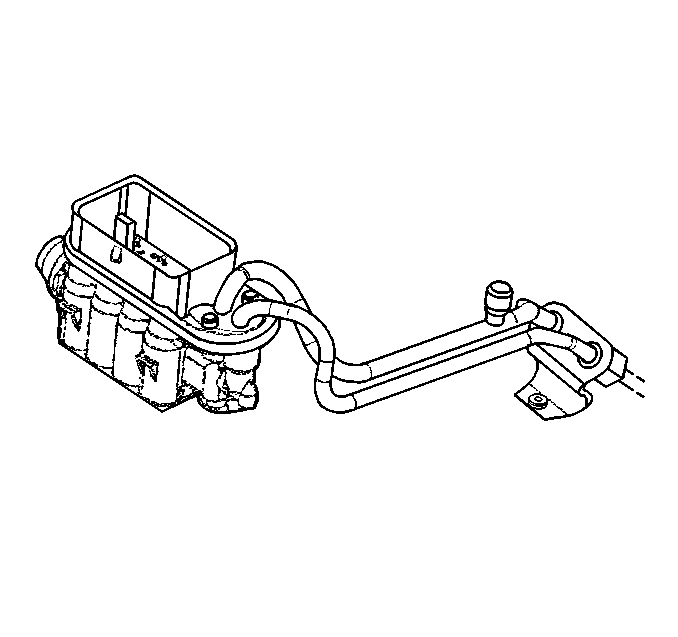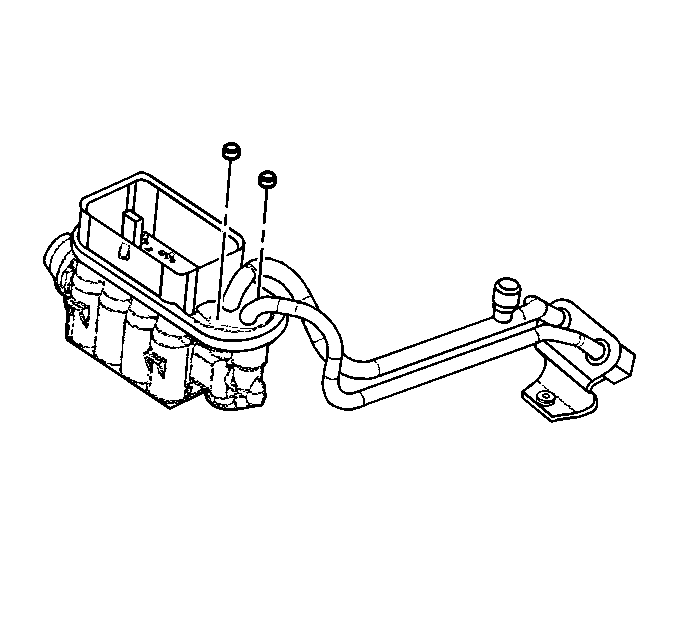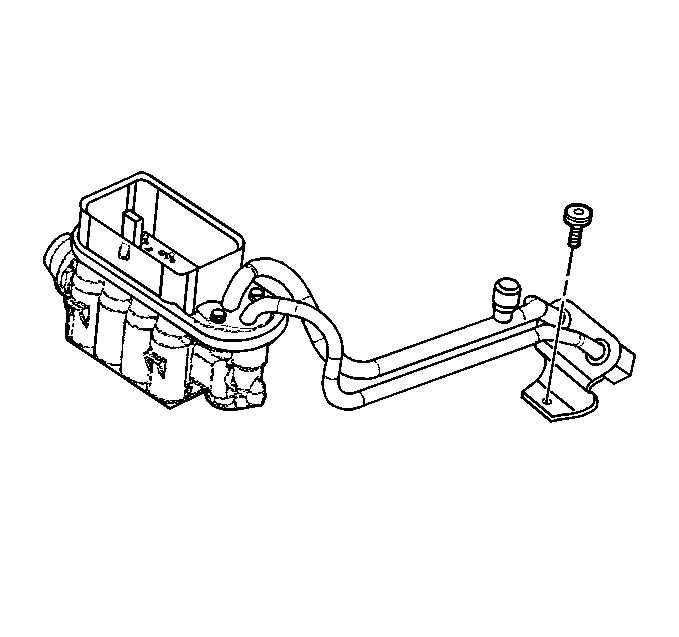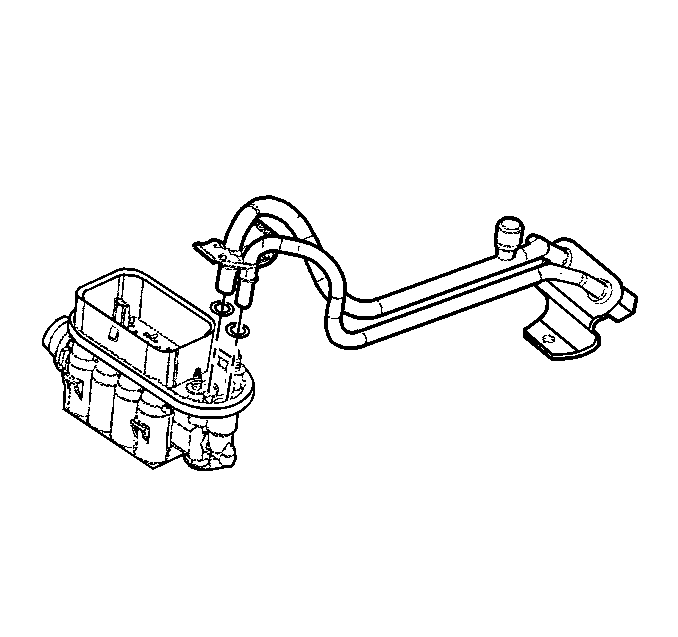Fuel Hose and Pipes Engine Fuel Pipes
Removal Procedure
- Disconnect the negative battery cable.
- Relieve the fuel system pressure. Refer to the Fuel Pressure Relief Procedure .
- Disconnect the fuel lines at rear of the intake manifold.
- Remove the nuts
- Remove the retainer
- Disconnect the injector fuel inlet pipe and the outlet pipe.
- Remove the rear fuel line bracket.
- Pull straight up on fuel pipe to remove fuel pipes from injector assembly.
- Remove the O-ring seals from both ends of the fuel feed and return pipes and discard.
Caution: Unless directed otherwise, the ignition and start switch must be in the OFF or LOCK position, and all electrical loads must be OFF before servicing any electrical component. Disconnect the negative battery cable to prevent an electrical spark should a tool or equipment come in contact with an exposed electrical terminal. Failure to follow these precautions may result in personal injury and/or damage to the vehicle or its components.




Important: Check the injector assembly to insure the O-rings have been removed.
Assemble Procedure
Install the new O-rings into the inlet and outlet of the fuel injector assembly, using the seal retainer tool.
Installation Procedure
Caution: In order to reduce the risk of fire and personal injury, before connecting fuel pipe fittings, always apply a few drops of clean engine oil to the male pipe ends.
This will ensure proper reconnection and prevent a possible fuel leak. During normal operation, the O-rings located in the female connector will swell and may prevent proper reconnection if not lubricated.Important: Remember to install the new O-rings into the inlet and outlet of the fuel injector assembly, using the seal retainer tool.
- Apply a few drops of clean engine oil to the male tube ends.
- Connect the fuel feed and return pipes to fuel assembly.
- Install the fuel pipe retainer and attaching nuts. Once installed, pull on both ends of each connection to make sure they are secure.
- Install the rear fuel pipe clip retaining bolt.
- Install the new O-ring seals on the engine fuel feed and return pipes.
- Connect the fuel feed and return lines to the engine fuel pipes.
- Tighten the fuel filler cap.
- Connect the negative battery cable.
- Check for fuel leaks.



Tighten
| • | Tighten the rear fuel line bracket bolt to 6.0 N·m (53 lb in). |
| • | Tighten the fuel pipe retainer nuts to 3.0 N·m (27 lb in). |

Tighten
Tighten the fuel pipe nuts to 30.0N·m (22 lb ft).
| 9.1. | Turn the ignition switch to the ON position for 2 seconds. |
| 9.2. | Turn the ignition switch to the OFF position for 10 seconds. |
| 9.3. | Again, turn the ignition switch to the ON position. |
| 9.4. | Check for fuel leaks. |
Fuel Hose and Pipes Fuel Hose and Assemblies
Steel fuel lines - These are welded steel tubes, meeting GM specifications 124-M, or its equivalent. The fuel feed line is 3/8 inches diameter and the fuel return line is 5/16 inches diameter. Do not use copper or aluminum tubing to replace steel tubing. Those materials do not have satisfactory durability to withstand normal vehicle vibration.
Coupled hose - Do not repair the hoses. Replace them only as an assembly.
Uncoupled hose - Use only reinforced fuel resistant hose, made of Fluoroelastomer material. Do not use a hose within 4 inches (100 mm) of any part of the exhaust system, or within 10 inches (2154 mm) of the catalytic converter. The hoses inside diameter must match the outside diameter of the steel tubing.
Clamps - These are stainless steel, screw bank-type clamps, #2494772, or equivalent.
Steel Fuel Line Repair
- Cut a piece of fuel hose 4 inches (100 mm) longer than the section of line to be removed. If you remove more than 6 inches (152 mm), use a combination of steel pipe and hose. The hose length should not be more than 10 inches total.
- With a tube cutter, cut a section of the pipe to replace. Use the first step to form a bead on the ends of the pipe and, also, on the new section of pipe, if used.
- Slide the hose clamps onto the pipe and push the hose 2 inches (51 mm) onto each portion of the fuel pipe. Tighten a clamp on each side of the repair.
- Secure fuel line to the frame.
- Check for leaks.
Fuel Hose and Pipes Service Quick Connect Fittings
Removal Procedure
- Grasp both sides of the fitting. Twist the female connector 1/4 turn in each direction to loosen any dirt within the fitting.
- Using compressed air, blow dirt out of the fitting.
- Choose the correct tool from J 37088-A tool set for size of the fitting. Insert the tool into the female connector, then push inward to release the locking tabs.
- Pull the connection apart.
- Use a clean shop towel in order to wipe off the male pipe end.
- Inspect both ends of the fitting for dirt and burrs. Clean or replace components/assemblies as required.
Caution: Wear safety glasses when using compressed air in order to prevent eye injury.
Notice: Use an emery cloth in order to remove rust or burrs from the fuel pipe. Use a radial motion with the fuel pipe end in order to prevent damage to the O-ring sealing surface.
Notice: Use an emery cloth in order to remove rust or burrs from the fuel pipe. Use a radial motion with the fuel pipe end in order to prevent damage to the O-ring sealing surface.
| • | Using a clean shop towel, wipe off the male pipe end. |
| • | Inspect both ends of the fitting for dirt and burrs. Clean or replace components/assemblies as required. |
Installation Procedure
Caution: In order to reduce the risk of fire and personal injury, before connecting fuel pipe fittings, always apply a few drops of clean engine oil to the male pipe ends.
This will ensure proper reconnection and prevent a possible fuel leak. During normal operation, the O-rings located in the female connector will swell and may prevent proper reconnection if not lubricated.- Apply a few drops of clean engine oil to the male pipe end.
- Push both sides of the fitting together to cause the retaining tabs/fingers to snap into place.
- Once installed, pull on both sides of the fitting to make sure the connection is secure.
